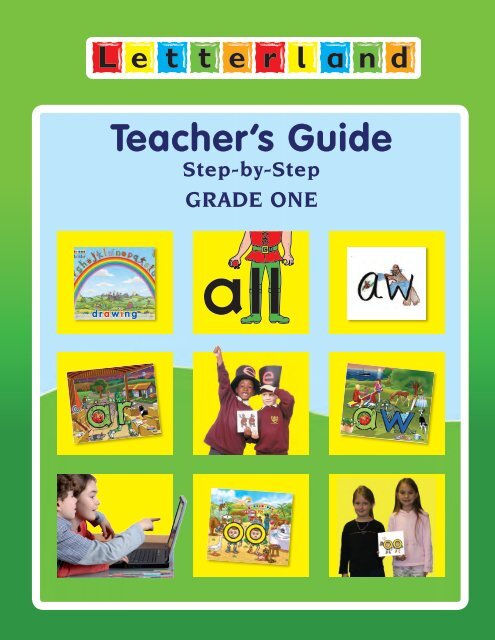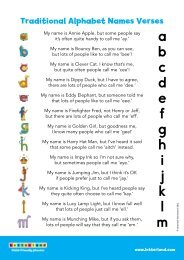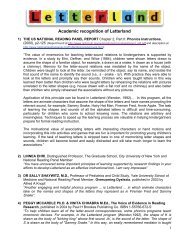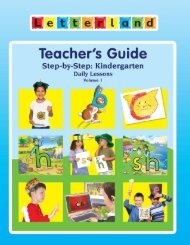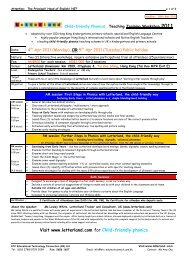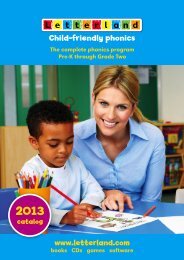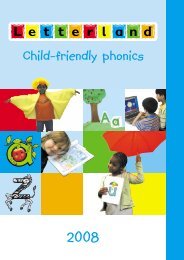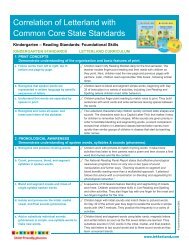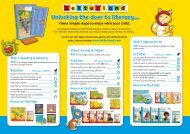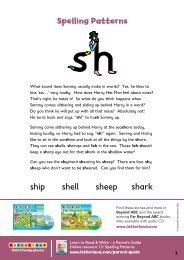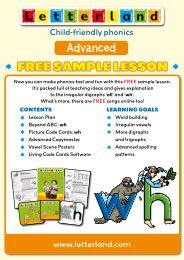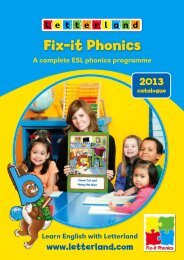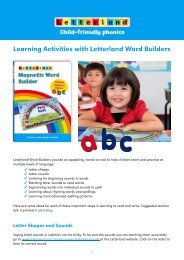Teacher's Guide - Letterland
Teacher's Guide - Letterland
Teacher's Guide - Letterland
Create successful ePaper yourself
Turn your PDF publications into a flip-book with our unique Google optimized e-Paper software.
Teacher’s <strong>Guide</strong>Step-by-StepGRADE ONEd r a w i n g
Sample PagesThe full printed guide is 250 pages in total. This e-book preview contains the followingsample pages:• Five Day Unit Plan Overview• A Road Map for Step-by-step Five Day Units• Sample Reproducible pages for each Unit• Step-by-Step Weekly Activities: Day 1• Homework Activities: Days 1 to 4• Comprehension ActivitiesPlease note:This e-book contains sample pages only - the full printed guide is 250 pages in total.
© <strong>Letterland</strong> International Limited. All rights reserved.ContentsThe <strong>Letterland</strong>ers .....................................................................1Scope and Sequence ............................................................. 2Five Day Unit Plan.................................................................... 3Road Map to Step-by-Step Units........................................... 4Step-by-Step Weekly Activities 7Day 1 ............................................................................ 7Whole GroupPhonic Concept Review .................................................... 7Introduce concepts on the pocket chart ......................... 7Live Reading........................................................................ 9Word Detectives.................................................................. 9Read new Word Cards in columns.................................. 9Tractors, Trains, Planes (and helicopters)........................10Small GroupTeacher builds words for reading ..................................10New Tricky Words and Story Words ...............................10Read Student List ..............................................................12Independent/PartnerWrite and mark up words, Read to two partners ........13Day 2 ...........................................................................13Whole GroupQuick Dash .......................................................................13Shared Reading of Songs................................................14Live Spelling........................................................................14Small GroupChildren build words.........................................................15Review Tricky Words and Story Words............................16Read Review Sentences...................................................16Independent/PartnerRead Review Sentences...................................................17Prepare for Game of the Week.......................................17Day 3 ...........................................................................17Whole GroupGuess Who?.......................................................................18Word Sort...........................................................................19Read the Decodable Story to the children....................20Small GroupDictate new Tricky Words................................................20Dictate 1 or 2 Review Sentences......................................21Children read the Decodable Story.................................21Independent/PartnerWritten Word Sort..............................................................21Day 4 .......................................................................... 22Whole GroupRed Robot's Reading Race..............................................22Play the Game of the WeekSmall GroupShare homework sentences...........................................23Reread the Decodable Story...........................................23Spelling Sort......................................................................23New Sentences dictation.................................................24Independent/PartnerWritten practice test with a partner................................24Fluency practice with a partner......................................24Day 5 ..........................................................................24Whole GroupSpelling Test......................................................................24Word Reading Fluency Check.........................................26Small GroupSuggested activities.........................................................26Independent/PartnerIllustrate and picture-code words..................................27Read the Decodable Story to two partners...................28
© <strong>Letterland</strong> International Limited. All rights reserved.Homework Activities..............................................................28Look-Say-Cover-Write-Check..............................................30Parent Homework Letter......................................................31Comprehension Activities.....................................................32Stone Story ........................................................................32Reader's Theater..................................................................32Plan and Play.......................................................................32Story Map .......................................................................32Preparing Children for Independent/Partner Activities...33Multisensory Activities for Blending and Segmenting.......34Game of the Week................................................................36Intervention Lesson Plans.....................................................40Step-by-Step Unit Plans 41Unit 1: Word families ad, ap, at..........................................42Unit 2: Word families ack, am, an......................................46Unit 3: Word families ix, in, ick............................................50Unit 4: Word families ock, op, ot........................................54Unit 5: Word families ell, et, en...........................................58Unit 6: Word families ug, un, ut..........................................62Unit 7: Word families Short Vowels ch, qu........................66Unit 8: The Vowel Men at the End.......................................70Unit 9: Giant All......................................................................74Unit 10: Best Friends at the End............................................78Unit 11: Consonant Blends with s.........................................82Unit 12: Consonant Blends with l.........................................86Unit 13: Consonant Blends with r.........................................90Unit 14: Final Blends nd, nt, st, sk.......................................94Unit 15: Words ending with nk, ng......................................98Unit 16: Magic e and Mr. A................................................ 102Unit 17: Magic e with Mr. I, Mr. O...................................... 106Unit 18: The Blue Magic, ce, ge.......................................... 110Unit 19: ee, e_e............................................................ 112Unit 20: ea..................................................................... 114Unit 21: ai, ay................................................................ 116Unit 22: oa, ow............................................................. 118Unit 23: igh, ie............................................................. 120Unit 24: ind, ild, old..................................................... 122Unit 25: ue, ui, ew....................................................... 124Unit 26: y=e................................................................... 126Unit 27: ed, ed (t)......................................................... 128Unit 28: ed (t), Magic ed............................................. 130Unit 29: ar, or............................................................... 132Unit 30: ore, oor, our (or)........................................... 134Unit 31: ir, ur................................................................. 136Unit 32: o/u, er............................................................ 138Unit 33: oo.................................................................... 140Unit 34: oo.................................................................... 142Unit 35: ow/ou, ou..................................................... 144Unit 36: oy, oi............................................................... 146Unit 37: aw, au............................................................ 148Unit 38: Contractions.................................................. 150Unit 39: spr, scr, spr, spl............................................. 152Unit 40: Compound Words....................................... 154Unit 41: Suffixes ly, ful............................................... 156Unit 42: Prefixes re, un.............................................. 158Unit 43: Comparative Endings, er, ers.................... 160Unit 44: Consonant l-e............................................... 162Unit 45: Short e spelling ea...................................... 164Small Group Intervention 192Appendices 219Glossary................................................................................262Index.....................................................................................263List of TG CD Grade 1 Contents........................................264
Sample PagesPage 3Five Day Unit Plan OverviewPage 4A Road Map for Step-by-step Five Day UnitsPlease note:This e-book contains sample pages only - the full printed guide is 250 pages in total.
© <strong>Letterland</strong> International Limited. All rights reserved.<strong>Letterland</strong> Step-by-StepGrade 1Five Day Unit PlanOverview of Day 1Whole Group• Review phonic concepts, p 7• Introduce new concepts on the pocket chart,p 7• Beyond ABC book (for some lessons)• Live Reading, p 9• Word Detectives, p 9• Read Word Cards, p 9Small Group• Teacher builds words for reading, p 10• New Tricky Words and Story Words, p 10• Read the Student List, p 12Independent/Partner• Write New Words and sentences, highlight,and read to partner, p 13Overview of Day 2Whole Group• Quick Dash, p 13• <strong>Letterland</strong> Songs/Beyond ABC book(for some lessons), p 14• Live Spelling, p 14Small Group• Children build words, p 15• Tricky Words, p 16• Read Review Sentences, p 16Independent/Partner• Read Review Sentences, p 17• Write words for Game of the Week, p 17Overview of Day 3Whole Group• Guess Who?, p 18• Word Sort, p 19• Read Decodable Story to the children, p 20Small Group• Dictate Tricky Words, p 20• Dictate 1 or 2 Review Sentences, p 21• Children read the Decodable Story, p 21Independent/Partner• Written Word Sort, p 21• Read Word Sort with partner, p 21Overview of Day 4Whole Group• Quick Dash, p13• Red Robot’s Reading Race, p 22• Play the Game of the Week, p 22Small Group• Share homework sentences, p 23• Reread the Decodable Story, p 23• Spelling Sort (Teacher dictates words), p 23• New sentence dictation, p 24Independent/Partner• Written practice test with a partner, p 24• Fluency practice with a partner, 24Overview of Day 5Whole Group• Spelling test, p 24• Fluency Check p 26Small Group• Choose from optional activities, p 26Independent/Partner• Illustrate & picture-code words, p 27• Read Decodable Story to 2 partners, p 283
© <strong>Letterland</strong> International Limited. All rights reserved.A Road Map for Step-by-Step Five Day UnitsEach of the 45 Step-by-Step Units includes four Teacher’s <strong>Guide</strong> pages of information andideas for your teaching and five reproducible pages on the accompanying Teacher’s <strong>Guide</strong>CD. These pages are explained below. Also on the CD: a set of Word Cards for each Unit.Features of PageOne of Each UnitThe Unit Focustells the phonicskills and otherobjectives ofthe Unit. Otherspecialinformation forteachers is alsoprovided.Diagnostic Words help youdecide if your children areready to move on to the nextUnit. These words are not onthe Students List (A, B or C) forthe week but are included ontheir Unit spelling test tomeasure transfer of skills tonew words.Tricky Words arecommon words in ourlanguage that areirregular or includepatterns not yet taught.In each lesson 1 to 4 areintroduced or reviewed.Selected wordsfrom previousunits are studiedeach week aspart of thecontinuousreview of newwords.The pocket chartshows howchildren will sortthe words basedon phonic soundsand patterns.Tricky Words andStory Words arealso listed.Story Words arewords from theUnit Decodablestory that havepatterns not yettaught. Childrenuse these mainlyin the storycontext.The Unit includes ListA, B and C so that ifyour children needmore practice youcan continue workingon the same skillsfor a second andthird week.Each Unit lists 12 to 14 <strong>Letterland</strong> PictureCode Cards that you will use for reviewactivities throughout the week.New Spelling Sentencesare practiced during theweek for reading andspelling and included onthe end of the Unitassessments.4
Sample PagesPages 5-6Sample Reproducible Materials ExplainedPlease note:This e-book contains sample pages only - the full printed guide is 250 pages in total.
© <strong>Letterland</strong> International Limited. All rights reserved.Sample reproducible pages for each Unit1) The Student List is used daily inthe classroom for a variety ofactivities.3) The Homework page is senthome on Day 1. Daily assignmentsare listed on the page.2) The Review Sentences providepractice with words from previousunits for reading and writtendictation.4) You may want to make bookletsfor each child of the first 18 to 20Units with these pages for each Unit:Student List, Review Sentences,Word Sort and Decodable Story.Then at mid-year make a secondbook of the remaining Units.<strong>Letterland</strong>Step-by-StepUnits 1-18Name ______5
© <strong>Letterland</strong> International Limited. All rights reserved.More sample reproducible pages and Word Cards3win3big3thickA Decodable Story for each Unitprovides practice with new phonicconcepts and Tricky Words.3 TWChildren categorize their words byphonic patterns and write them incolumns.to3 Sthings33thickTW3to thingsWord Cards in two sizescan be printed for eachUnit from the TG CD withcards for List A, B, & Cwords, Tricky Words, andStory Words.6
Sample PagesPages 7-13Step-by-Step Weekly Activities: Sample Lesson for Day 1• Overview of Day 1• Whole Class• Live Reading• Small group• Tricky Word Practice• Independent/Partner.Please note:This e-book contains sample pages only - the full printed guide is 250 pages in total.
© <strong>Letterland</strong> International Limited. All rights reserved.Step-by-StepWeekly ActivitiesEach Unit in this Teacher’s <strong>Guide</strong> followsthe same five day plan. The activities for eachday of this plan are described in detail below.Activities are provided for three classroomsettings: Whole Class, Small Group andIndependent/Partner. In addition to classroomactivities, homework activities are included foreach day (p 28).You may decide to use all these settings andactivities in your classroom or you may choosethose that best suit your children and yourclassroom set up.To become familiar with all these options, wesuggest you read through this section beforebeginning the Units. Once you have begun theUnits, you may find it helpful to refer to portionsof this section from time to time.DAY 1Overview of Day 1Whole Group• Review phonic concepts• Introduce new concepts on thepocket chart• Beyond ABC book (for some lessons)• Live Reading• Word Detectives• Read Word CardsSmall Group• Teacher builds words for reading• New Tricky Words and StoryWords• Read the Student ListIndependent/Partner• Write New Words and sentences,highlight, and read to partnerWhole Class – Day 1Setting In most classrooms, the teacher will wantto teach the Units in sequence to all the students inthe class. Even if you have some small groups ofstudents working in earlier or more advancedunits, all of your children will benefit from theexposure to and participation in the whole classlesson The whole class lesson is designed forabout 30 minutes on Day 1 and about 20 minuteson Days 2-5.Phonic concept reviewMaterials Picture Code Cards (PCCs) These areintroduced or featured in the Unit just previous tothe current one.Procedures• Ask children to tell the sound and retell the<strong>Letterland</strong> story that explains the sound.• Specific directions are provided in each Unit.What is the purpose of this activity?• This review of phonic concepts is meant to be aquick refresher on the patterns taught in theprevious Unit. On Day 2, 3, and 4 there is amore thorough review of letter sounds andpatterns from several previous Units. Because ofthe extent of activities on Day 1, there is limitedtime for review. This brief review is importantas it will often help build a link with newconcepts to be taught in the current Unit.Introduce concepts on thepocket chartMaterials Picture Code Cards These are listed atthe beginning of the activity (In some Units, youwill also use the illustrated book, Beyond ABC,and/or the Blends and Digraphs Songs CD.)Procedures• Within the Unit pages you will find specificinstructions for using the above materials toexplain the <strong>Letterland</strong> story or ‘phonic fable’ thathelps children understand and remember thesounds being taught.• After sharing the story you will use the PCCs tomake a few words on the pocket chart for thechildren to decode. The PCCs needed and thewords to make are listed in each Unit.7
© <strong>Letterland</strong> International Limited. All rights reserved.spell the listed words, one per child. Then line upthe children with the letters in the first wordfacing the class holding their PCCs for all to see.• Stand behind the ‘<strong>Letterland</strong>ers’ (the childrenholding the PCCs). They make their lettersounds in sequence as you tap each one’sshoulder.• In this part of the lesson and in a number of otherUnit activities, children use various multisensorystrategies to help them blend words for reading.These strategies include the Rollercoaster(blending sounds as your right hand slides downyour left arm) and Finger Sounding (children usetheir fingers to represent sounds). These methodsare described in detail in the Teaching Strategiessection (Roller-Coaster, p 34; Finger-Sounding,p 34).• Variations To add some variety and to providethe best focus on a particular concept, someUnits may call for you to introduce the newconcepts with Live Reading (usually the nextstep below) or with Live Spelling (usually doneon Day 2).What is the purpose of this activity?• Using the Picture Code Cards on the pocketchart is an excellent way to focus children’sattention on the phonic concept and the phonicfable in a calm, quiet setting. It is a briefintroduction that usually sets the scene for themore active Live Reading activity that follows it.Children have the opportunity to listen carefullyto the new ideas that they will be using the restof the week in reading and spelling activities.Live ReadingMaterials Picture Code Cards listed at thebeginning of the activity, and a Reading Directionsign (Appendix). On occasion props for the<strong>Letterland</strong>ers such as a hat for Harry Hat will belisted (Costumes and Props, Appendix).Procedures• In Live Reading, children get a chance to be the<strong>Letterland</strong>ers. You distribute the PCCs needed toLive Reading• Arrange children holding PCCs toform the word.• The children holding the PCCsmake their sounds in order.• The other children Finger Soundor Rollercoaster blend the word:/r/ /u/ /n/, run.• You or one of the children saythe word in a sentence.• Build the next word.• Next hold your hand over each <strong>Letterland</strong>er asthe class Finger-Sounds the word.• Then sweep your hand above the <strong>Letterland</strong>ers asthe class blends the sounds to make a word. It isa good idea to say a brief sentence with the wordat this point to make sure everyone understandsthe word.• In many lessons, you will then change only oneor two letters by letting other children with PCCsswap places to make the new word.• Children continue to use their multisensoryblending strategies to sound out the words.What is the purpose of this activity?• In Live Reading children use their imaginationsto actively play at the process of making words,changing words, and acting out the ‘phonicfables’ that support their reading and spellingdevelopment.8
© <strong>Letterland</strong> International Limited. All rights reserved.search for the phonic elements and using them toread the words.Word DetectivesMaterials Two to four sentences from the Unitinstructions that you write on sentence strips, charttablet or chalk board; high lighters, chalk, ormarkers.Procedures• The sentences provide several examples of thephonic concepts being taught.• These sentences often involve the adventures ofthe children’s <strong>Letterland</strong> friends. They learn torecognize the <strong>Letterland</strong>ers’ names easily bylooking for the repeated capital letters in eachname (Bouncy Ben, Golden Girl, UppyUmbrella, etc. See the Character Names Trickp 109.)• After reading a sentence to the children and thenwith the children, they come to the board andpicture-code (Appendix) the featured phonicelement or they may simply highlight orunderline the words with these elements. Thetargeted features are highlighted in thisTeacher’s <strong>Guide</strong>. Some Units may call forcoding vowels as long or short, or for otherspecial markings as well.Magic E came and made Mr. Aappear.Kate and I have the same name.That cave by the lake is notsafe.• Reread the sentences and then point to individualwords for the children to identify.• These sentences are not strictly vocabularycontrolledsince you will be reading them to thechildren first. (Other sentences and stories inthese Units that children will read and write arelimited to words that have been taught directly orthat contain only letter sound patterns that havebeen taught.)What is the purpose of this activity?• Word Detectives lets children see and use thenew concepts in a meaningful sentence contextright away. They also benefit from having toRead new Word Cards in columnsMaterials For each Unit, there is a set of 18-24Large Word Cards. The cards include decodablewords using the phonic elements being taught, afew Tricky Words (irregular, high-frequencywords that are often called ‘sight words’) and afew Story Words from the Decodable Story forthe Unit. You will also need a ruler or some kindof pointer.Procedures• Before the lesson, display the Word Cards (ListA, B or C) as illustrated in the Teacher’s <strong>Guide</strong>pages for each Unit (see Unit 1 words in thepocket chart illustration below). Leave a space atthe top for the Picture Code Cards which will beused in earlier lesson activities first.madDadnaplapcathatmyTrickyWordsStoryhad map sat Wordsat on a(The chart above shows only list A words.)• The cards are placed so that all the words in acolumn include the same phonic element. (e.g.words with the -ad rhyming pattern in theillustration above, first column) with the relatedPCCs at the top.• Use a pointer of some kind such as the StarWand pictured above.• Point to the words starting at the top and movingto the bottom and have children read them. (ForTricky Words and Story Words read the group ofwords to the children before asking them to readthem.)• Use your voice to get them started but then fadeyour voice out so that you can hear the childrensaying the words on their own.• Read the column of words several times going abit faster on each run through. Use thesuggestions below to make this repetition morefun by pretending to be...Ithe9
© <strong>Letterland</strong> International Limited. All rights reserved.Tractors, Trains, Planes (and Helicopters)• Tractors plow slowly through each word. Thisis usually used for the first reading. You maywant to slide your pointer under each lettercueing children to slowly blend the sounds into aword.• Trains move along at a steady pace but not toofast.• Planes really move along pretty fast—fastenyour seat belts before trying this one.• Helicopters can go up and come downanywhere. When you are helicopters you don’tgo straight down the column but skip around in arandom order. After practicing all the columnsyou can be Helicopters hovering from onecolumn to another.• You might also let a few children try reading acolumn in pairs or threesomes with the childrenchoosing whether they want to be tractors ortrains, etc.What is the purpose of this activity?• Reading the Word Cards provides practice usingthe new phonic concepts in a supportive settingto decode words and to begin to recognize thewords more quickly.Small Group – Day 1Setting Meeting in small groups of children withsimilar needs helps you provide the bestinstruction for each child. In small groups it iseasier to maintain attention and each child getsmore chances to respond and receive feedback.Some small groups may be working on a differentUnit from the majority of the class. In this caseyou will need to adapt some of the Whole Classactivities for the Unit that the small group isworking on (See Intervention, p 40).Teacher builds words for readingMaterials Picture Code Cards (PCCs) listed atthe beginning of the activity.Procedure• This activity can be done by placing the PCCs ina pocket chart or using them on a table with yoursmall group. You may want to use the plainletter side of the cards. You could also use thepicture-code side for recently introduced soundsor whenever children need the extra support.• Spread your PCCs out so they are easy for youto locate.• Make the first word on the list and have thechildren Finger-Sound it or Roller-Coaster it ontheir arms (p 34-35).• Usually, the next word only differs from theprevious word by one letter (e.g. lip to slip, coatto cot). You will be able to quickly change fromone word to another.• Have the children Finger Sound or Rollercoastereach word. At times you might call on anindividual child to Finger-Sound the word. Thenlet the whole group do the same.• In some lessons additional instructions help youcall attention to new concepts or provideinteresting variations on this activity.What is the purpose of this activity?• Reading the words that you build requirescareful attention to each part of the word andprovides lots of practice decoding words usingthe new phonic concepts.New Tricky Words and Story WordsMaterials A small chalkboard or white board,Story word cards from Unit Word Cards (TG CDG1), writing materials for the children.What are Tricky Words?• Tricky Words is the label given to wordsincluded in the Unit that do not fit with the lettersound patterns taught to that point. This categoryincludes many of the irregularly spelled wordsthat we use most in our language: was, are, said,from, etc. It also includes common words thatmay be fairly regular but contain patterns not yettaught: how, why, her, etc.10
© <strong>Letterland</strong> International Limited. All rights reserved.• A Unit may have from 1 to 4 Tricky Words.Children are expected to learn to read and spellTricky Words over the 5 days of Unitinstruction. Tricky Words are included in theWord Cards for the Unit. (These may be printedor photocopied from the Teacher’s <strong>Guide</strong> CD—TG CD G1). Tricky Word cards are labeled by‘TW’ to the right of the Unit number. Thesewords are listed on the first page of each Unit inthe Teacher’s <strong>Guide</strong> and on the reproducibleHomework page and Student List for the Unit(TG CD G1). Tricky Words are used in theSpelling Sentences and in the Decodable Storyfor the Unit.Procedure for Tricky Words• Write the first Tricky Word on the white board.• Say the word and use it in a brief sentence.• Help children hear the sounds in the word withrubber-band-stretching or Finger Sounding(p 34-35). With the children, identify theletter(s) that do not ‘sound right’ in the word(e.g. the a in was, the ai in said). Indicate theseletters with a wavy line underneath. If there aresilent letters, rewrite them with a dotted line.wasdonsaidclim• The letters that need to be made in dotted linesor with a wavy line beneath are identified in thetext of each Unit in this Teacher’s <strong>Guide</strong>.• After identifying the letters to be marked asabove, follow the 3x3 Tricky Word Practiceroutine (see box opposite).Air-tracing Children look at the word on thewhite board and trace the letters in the air withtheir fingers using the following three steps.1) First they say the word (e.g. “done”).2) Then as they trace each letter they say itsletter name (dee-oh-en-ee). 3) They air-trace aline under the word as they say it again(“done”).This process is repeated three times, a) firstwith a normal voice, b) then in a whisper, andc) finally, children silently move their mouthsas if saying and spelling the word.Invisible writing Next ask the children if theyare ready for you to erase the word. If not, theypractice a bit more. Now, everyone traces theletter with their fingers on the table or carpetthree times always saying the word, tracing,and repeating the word. Once again, theychange the voicing of each repetition as above:aloud, whisper, and silently mouthing of theletter names and the word.3x3 Tricky Word PracticeSay it. Spell it. Say it again.Air-tracing• Aloud• Whisper• Silent (with mouthmovements)Invisible writing• Aloud• Whisper• Silent (with mouthmovements)Visible writing• Aloud• Whisper• Silent (with mouthmovements)Visible writing As the last step, children writethe word three times following the sameprocedure as with air-tracing and invisiblewriting. They can write on an erasable surfaceor on paper. They should erase or cover theword after each writing so that they are writingeach time from memory rather than copying.The process is summed up in the box above.• Follow the above steps with one or two TrickyWords. Save additional Tricky Words for Day 2.What are Story Words?• Story Words are words that are included in thereproducible Decodable Story for the Unit(TG CD G1). These are words that have spellingpatterns or other features that have not yet beentaught. They are included in the story to addmeaning and interest. Children are not expectedto remember all these words out of context.11
© <strong>Letterland</strong> International Limited. All rights reserved.• Many of the Story Words will appear as ListWords or Tricky Words in later Units. StoryWords are underlined in the Decodable Storyand listed on the first page of each Unit in thisTeacher’s <strong>Guide</strong>. Story Words are included inthe Unit Word Cards and are labeled with the anS to the right of the Unit number. TheHomework page and Student List also includethe Story Words.Procedure for Story Words• Use the Word Cards for the Story Words. Tellthe children that these are words from the storythat you will all be reading later in the week.• Show the first word, say it, use it in a briefsentence, and say it again.• Tell children that when you point to the card,they should say the word. Silently count to threeand then point to the card.• Do the same with each word.• Go back through the cards one or two times andhave children say them again when you point.Wait about two or three seconds before pointingto each word.• If there is confusion about the words, point outsome feature of the word that will help themremember it. For example, This is bear. Wecan hear the /b/ at the beginning andthe /r/ at the end.What are the purposes of these activities?• Practicing Tricky Words helps children learn toread and spell many of the words that occurmost often in our language. Practicing the StoryWords prepares children to read the DecodableStory. Some children may retain these words andmake use of them in reading other books. The 3second ‘wait’ time before having children repeatthe word requires them to briefly hold the wordin memory and may give needed ‘think time’when the words are reviewed.Read Student ListMaterials Copies of the Student List for the Unitfrom the Teacher’s <strong>Guide</strong> CD G1.Procedures• Read the Tricky Word list to the children andthen have them read it with you. Do the samewith each of these lists: Tricky Words forReview, Review Words, New Words (List A, B,or C—normally you will be reading list A,unless your class or group is repeating the Unit).• Read the New Sentences to the children andhave them read them with you.What is the purpose of this activity?• By reading the Student List to and then with thechildren you are preparing them to accuratelyread the same list later in partner practice and forhomework. It is important that they practicereading the words accurately; otherwise theycould be practicing errors. The practice ofreading this list accurately at different times andin different settings will help the children readthese words more fluently when they meet themin other reading contexts.Independent/Partner – Day 1Setting While you are meeting with Small Groupsother children will have time to work on their ownor with a partner. You will want to prepare them tobe responsible for completing the suggested<strong>Letterland</strong> activities as well as other literacy tasks(see Preparing Children for Independent/PartnerActivities, pp 33).Write and mark up words, Read totwo partnersMaterials Copies of Student List for the Unit (TGCD), writing materials (paper and pencil),highlighters or crayons or colored pencils.12
© <strong>Letterland</strong> International Limited. All rights reserved.Procedures• Children copy the ten words in the New Wordslist (A, B, or C) from their Student Lists. Theyalso copy the New Sentences. Then theyhighlight or underline the new phonic elementsin the words and sentences that were highlightedor picture-coded in the whole class WordDetectives activity. (Leave the Word Detectivessentences in clear view for reference.) SomeUnits may call for coding vowels as long orshort, or for other special markings as well.• After the children have written and highlightedtheir words, they meet with a partner to compareand correct their papers. Then the first partnerreads the words to the second partner and viceversa. To indicate that this has been done, eachpartner signs the other partner’s paper. Nexteach child meets with a second partner to readthe words again and sign each other’s papers.What is the purpose of this activity?• Children get practice writing the words. Findingand highlighting the new concepts helps them inrecognizing these phonic elements. Reading thewords to a partner helps to make sure the childknows the words, and reading to two partnersprovides more practice toward fluency.DAY 2Whole Class – Day 2Quick DashMaterials 12 -14 Picture Code Cards (PCCs)listed on the first page of the Unit.Procedures• Hold the picture side of the first PCC for all tosee. Ask the children to wait until you touch thecard with your other hand, and then to name thecharacter (e.g. “Vicky Violet”). (This allowsyou to give some ’think time’ to children whomight not be quick with the character names.)• Next turn the card to the plain letter side andsay, Sound? Children respond with the lettersound (e.g. /vvv/).• Optional: Trace the plain letter with your fingeras if writing it and say, Letter name?Children respond with the letter name (e.g.“vee”).• Follow the same steps with the rest of the PCCs.• Then tell the children it is time for a SoundsRace. Go quickly through the cards showing theplain letter side and having child respond withthe sound only (e.g. /vvv/, /mmm/, /ĕ/, /g/).• Go through the cards two or three times, eachtime a just a bit faster.• Changes over time As children who are new to<strong>Letterland</strong> become thoroughly familiar with thecharacters and sounds, you may want to skipnaming the characters on most days and onlywork on sounds.You will find after several weeks that many of thePCCs you are using will be consonant digraphs(th, sh, wh, kn) or spelling patterns like (ea, er,ow, igh). Use the picture side of these for thoserecently introduced PCCs to review the phonicfable that explains the sound. (Once children havemastered these, they can usually supply the storiesthemselves.)“VickyViolet”/vvv/13
Sample PagesPages 28-29Homework Activities: Day 1 to 4• Classroom preparation• Assignment.Please note:This e-book contains sample pages only - the full printed guide is 250 pages in total.
© <strong>Letterland</strong> International Limited. All rights reserved.HomeworkActivitiesHomework activities are intended to provideadditional practice in reading and writing the Unitwords.Homework activities for Days 1 through Day 4are listed on the Homework page for each unit.The same activities are used every week with thenew words and sentences from the current Unit.For each of the four daily assignments belowthere is a “Classroom Prep” paragraph withsuggestions for demonstrating or reminding thechildren of what they need to do for homeworkthat day. You will, of course, want to spend moretime with this in the first few Units until childrenand parents are used to the routine. It will continueto be important to at least briefly review thehomework assignment each day throughout theyear preferably near the end of the school day.A letter explaining the activities for parentscan be found on page 31. It would be very helpfulto demonstrate and discuss the activities at aparent meeting early in the school year. Childrenwill need support at home to complete theseactivities. When that is not possible due tolanguage differences or parent working hours theschool should strive to provide extra help for thosechildren during the school day, or before or afterschool to complete homework assignments.Day 1 Homework• Classroom Prep As shown in the illustration,children circle the lists of Tricky Words, TrickyWords for Review, Review Words, the assignedlist of New Words (A, B, or C), and the NewSentences. This makes clear to the children andparents which words they are to read forhomework.• Assignment Children read through once all thewords and sentences that they have circled, andthen go back and read it all again. The child hasa parent or other adult sign under the Day 1assignment on the Homework page.Day 2 Homework• Classroom Prep Demonstrate the Look-Say-Cover-Write-Check method (see pages 30-31)on the board. Then have children practice two orthree words on their own. After a few weeks,have a child demonstrate on the board.• Assignment Children follow the steps on theLook-Say-Cover-Write-Check reproducible(p 30). These steps are also included in theparent letter (p 31).Day 3 HomeworkClassroom Prep To encourage children to writebetter sentences, say something like this. ImpyInk is a very good writer. We want to belike Impy Ink and write very interestingand imaginative sentences. Tell me whichsentence is more interesting. 1) The catran. 2) The sleek gray cat charged afterthe squealing mouse. Talk about why it ismore interesting. Let children try to say someinteresting sentences with one of the Unit words init. Prepare the children to expect the importantfollow-up step below when they return with theirsentences on the next day.)28
• Assignment Children write five (5) sentencesusing at least one List word in each one.• Follow-up When children bring in thesentences they have written, let them share someof them in whole group or better yet in smallgroups. After a child reads a sentence, discusswith the class what makes the sentenceinteresting and occasionally discuss what mightbe done to make it even more interesting.Day 4 Homework• Classroom Prep Tell children that they need tohave some one at home read out the New Words,a few Review Words, and New Sentences.(Tricky Words are included in the sentences.)The child writes the words and sentenceswithout first seeing the Homework list untildone. Then any missed words should bepracticed using Look-Say-Cover-Write-Check.• Assignment Children take a practice spellingtest at home. They practice missed words withthe Look-Say-Cover-Write-Check strategy.© <strong>Letterland</strong> International Limited. All rights reserved.29
Sample PagesPages 32-37Comprehension Activities• Preparing Children for Independent/Partner Activities• Multi-sensory Activities for Blending and Segmenting Words• Game of the week: Bouncy Ben’s Bingo GamePlease note:This e-book contains sample pages only - the full printed guide is 250 pages in total.
© <strong>Letterland</strong> International Limited. All rights reserved.ComprehensionActivitiesSeveral activities that promote engagement andcomprehension are described below. These can beused with the Decodable Stories that accompanyeach Unit or they may be used with some of thesong lyrics from the <strong>Letterland</strong> Blends andDigraphs Songs CD that you use for sharedreadings.Some of these activities are suggested specificallyfor certain stories in the Unit lesson plans, but youmay also find them useful with other stories orsong lyrics.Story Stone• You will need an interesting looking stone orpebble. Tell children that this is the Story Stone.After reading a story, have children use it to helpin a group retelling of the story.• When someone is holding the StoryStone, everyone should be listening tothat person. The first person will tell thebeginning of the story and passes theStory Stone on to another person whothen tells the next part. Then anotherperson gets the Stone and tellssomething the others have not yet saidabout the story. It is important to listen tothe person with the Story Stone, so youcan add something new to our retellingof the story.. Who wants to begin withthe Story Stone?Reader’s Theater• Reader Theater stories provide an easilyunderstood reason to reread the sentences. Thismethod works especially well with stories thatinclude dialog, but it can be adapted for any text.Plan ahead and divide the story into parts to beread by each child or group of children. Youmay want to let the children help decide how thetext should be assigned.• If there are direct quotes, these should be read byassigning one child or group per character.Remember the ‘she said’ or ‘he asked’ partsshould be read by a Narrator rather than thecharacter. There can be several Narrators to givemore children a part.• A good way to designate which part should beread by whom is to use a copy of the story foreach role and highlight the parts to be read bythat child. After reading through the story a timeor two with the designated parts, the childrencan exchange copies and take on a new role.• Remember Reader’s Theater is just for reading.Usually there is no action or props and theredoes not need to be audience. This allowschildren to focus on the reading and to providethe drama with their voices. If you want a moreactive dramatization, see Plan and Play below.Plan and Play• Use this with stories that lend themselves todramatizing with movement. (It will also worknicely with many of the Blends and DigraphsSongs). After reading the story a few times, youand the children plan together the actions toaccompany the reading. Part of the group will bereaders (you might let stronger readers read first,giving others a chance to become more familiarwith the story by acting it out before beingreaders themselves). The readers will read aportion of the text and then stop for the others toact out that part.• Reread the story with the children with the ideaof planning who the characters are and what thesequence of action will be. You might alsodiscuss what the actors might say, addingadditional dialog to fill out the story.• Stop at several points in rereading to plan youractions. You may want to make a list of theactions as a Shared Writing exercise.• Review the steps you have planned together anddecide who will do each action. Designate partof the group as readers and decide who will readwhat (All can read chorally or the text can bedivided between readers). Decide where thereaders will stop for the actions to take place.• Then proceed to carry out the plan. After one ortwo readings, let readers and actors trade roles.You might also want to provide a chance forchildren to add new ideas to the plan.32
© <strong>Letterland</strong> International Limited. All rights reserved.Story Map• Make a simple story map (such as the one shownbelow) and project it or write it on the board or achart tablet. <strong>Guide</strong> children in a Shared Writingby filling in the basic elements of the story.Story MapCharacters (Who)Setting (Where and When)Problem (What does thecharacter want or need?)• Review the list with the children. Then have onechild or pair of children demonstrate how to dothe task using the guidelines created by thechildren.• Have another pair of children demonstrate hownot to behave during this partner activity (or onechild for an independent activity). Then havethat same pair demonstrate the correct way to dothe activity.• Next have everyone practice the same activityfor a very limited time (1-3 minutes).• Bring everyone back together to discuss howthey did at following their guidelines.• Practice the activity again immediately for 1-3minutes and discuss again.You will probably need to practice the activity forseveral days with the whole group for shortperiods.Then begin the same steps with another activitythat you want children to be able to doindependently or with a partner.Solution (How is the problemresolved?)Preparing Children forIndependent/PartnerActivitiesAt the beginning of your school year beginpreparing children to work independently and withpartners without disrupting the class. These tipswill help. These ideas are adapted from anexcellent book that we recommend to allelementary teachers by Gail Boushey and JoanMoser called The Daily Five: Fostering LiteracyIndependence in the Elementary Grades (2006,Portland, ME, USA: Stenhouse Publishers).• Talk with the children about a particular activitysuch as Reading Words to a Partner. Make aposter about how to work with a partner withideas brainstormed by the children such as:• Take turns.• Use quiet voices.• Find a place where you won’t botheranyone, etc.33
© <strong>Letterland</strong> International Limited. All rights reserved.Multi-sensory Activitiesfor Blending andSegmenting WordsThese activities provide actions for children touse as they blend and segment words. Along withusing their voices, mouth movements, eyes andears, the hand movements provide Visual-Auditory-Kinesthetic-Tactile (VAKT) stimulationas children blend and segment sounds to read andspell words. Also, active use of their hands helpsto focus children’s attention and lets you observetheir level of participation unobtrusively.You will use these actions with children inseveral of the whole group and small groupactivities during the five day Unit. Usually, youwill make the motions with them unless you wantto observe one or more children’s actions withoutteacher support. In addition, you will want toencourage your children to use these methods asneeded when they are independently reading orwriting.As they touch the parts of the arm they say thesounds or phonemes of the word. They mayrepeat the sounds touching each part of the armagain (this aides in holding the sounds inmemory).• Next children slide the right hand from theshoulder to the inside of the elbow as they blendthe first two sounds. Then they touch at the wristand say the last sound.• Then children slide the right hand all the wayfrom shoulder to wrist as the sound of the firsttwo with the third sound.• Usually you will want children to repeat theblended word in a quicker, more naturalsounding way as they quickly slide their handsdown their arms again.• It is a good idea to use the word in a quickphrase or sentence to make sure everyoneunderstands the word.mmmăăăpActivities for BlendingSounds to Read a WordUse the activities described below when theobjective is to read an unknown decodable word.They are valuable in Live Reading, reading wordsmade with Picture Code Cards, and anytime thechild needs to sound out an unknown word.The Rollercoaster Trick (Arm-Blending)The Rollercoaster Trick (arm-blending) involveslarge movements with both arms and should beused when first teaching children to blend.Children in kindergartens using <strong>Letterland</strong> Stepby-Stepwill have learned this technique and mayhave already ‘graduated’ to Finger Sounding(below). Children already using Finger Soundingmay need to revert to the Rollercoaster whenblending new types of spelling patterns (especiallywhen they are introduced to consonant blends inUnits 11-15).Basic Procedure• Children look at the letters in the word and thenput the sounds of the word on their arm (forthree sound words, this usually means touchingthe right arm, first to the left shoulder, then tothe inside of the elbow, and then to the wrist.)mmmăăăp,mapFinger SoundingFinger Sounding serves the same purpose as theRollercoaster, but it involves smaller, quickermovements. Once you are sure children areconfident at blending sounds, you may want themto use mostly Finger Sounding to read anyunknown words.• Finger Sounding can be done in two ways:1) Finger Pop-Ups 2) Finger Tapping.• In both methods of Finger Sounding, each fingerrepresents one phoneme. So in words withdigraphs such as the ch in much, the digraphonly gets one tap. Much is tapped with threefingers. Other consonant digraphs such as ck, sh,th, wh, kn, and ph also all receive only one tap.• The same one-tap-per-sound applies to voweldigraphs such as ee, ea, ai, ay, oo, ow, andmany more.34
© <strong>Letterland</strong> International Limited. All rights reserved.• Silent letters are not tapped, e.g. through, climb,and gave.Finger Pop-UpsFinger Pop-Ups may be easier for some childrenwho do not yet have the coordination for FingerTapping. When children are reading unknownwords, they begin with a fist and pop up one fingerfor each sound in the word. Then they pull theirfingers back into a fist as they blend all the soundsinto a word.Finger TappingIn Finger Tapping the child touches each finger tothe thumb in sequence saying a sound with eachtap. Then the child sweeps the thumb across thefingers to blend the sounds into a word (or simplytouches all the fingers to the thumb at once).FingerPop-UpsFingerTappingActivities for SegmentingWords to SpellUse the activities below when the objective is tolisten for the sounds to spell a word. Suchactivities include Live Spelling, spelling wordswith <strong>Letterland</strong> Word Builders, and any time achild is unsure of the spelling of a word.Playing Pitch and Catch with Words’This is a good way to make sure you haveeveryone’s attention and to prepare them to say thewhole word in a normal fashion before attemptingto segment the word. You can use it with bothrubber-band-stretching and Finger Soundingbelow.• Tell the children you are going to pretend topitch a word to them. Hold up you handready to catch a ball. You catch theball by repeating the word I say.• Say the word as you make a pitching motion.The children repeat the word as they make acatching motion.• Now their hands are up and they are ready torubber-band-stretch the word or to FingerSound.Rubber-band-stretching• Tell the children to hold their hands in front ofthem palm to palm. Let’s pretend we havea big rubber-band wrapped around ourhands and we want to stretch it out butwe have to go slow because it is astrong rubber-band.• Have them slowly stretch their hands out andback in a few times. When we bring ourhands back together we have to useour strong muscles and make our handscome back together slowly and silentlybecause we are going to be listening forsounds in words.• Let’s try stretching out someone’s name.How about Jasmine. It may sound likeyour Momma’s calling you from downthe block. Everyone slowly pulls their handsapart as they say, “Jaaaasssmmmiiiinnnne.”Try a few other names to get children used to theidea of slowly saying all the sounds in the wordin stretched out fashion.• ‘Stop’ sounds such as those for b, c, d, g, j, k, p,q, t, and x can not be stretched’ but most othersounds including all the vowels can beprolonged.• To rubber-band-stretch a word for spellingeveryone says the word slowly as they pull theirhands apart as shown below.ssssăăădssss ăăă d• Then everyone begins to stretch the word again,this time ‘jiggling out’ the first sound by movingthe hands back and forth a bit just afterbeginning to say the word. Then stretch aboutmidway and ‘jiggle out’ the vowel sound. Finallystretch hands out to the farthest position andjiggle out the final sound. (If using a word withmore than three sounds, then stop at the35
© <strong>Letterland</strong> International Limited. All rights reserved.approximate place in the movement when youare saying each sound.)• When children are first learning to segment, e.g.in Live Spelling, you may need to stop afterjiggling out each sound and decide which<strong>Letterland</strong>er to put in place as you build theword. This choosing a letter or <strong>Letterland</strong>er oneat a time could also be used with <strong>Letterland</strong>Word Builders or for writing words.• Once you are confident your children can hearall the sounds in most three sound words, youmay want to switch to Finger Sounding for mostactivities. Always return to rubber-bandstretchingwhenever children are havingdifficulty segmenting a word. It will be usefulwhen you move from three phoneme words tofour phonemes beginning with Unit 11.Finger SoundingFinger Sounding works for both blending andsegmenting once children are confident with theseskills.• For segmenting you will want to first pitch theword for children to catch. They repeat the wordas they catch it.• Then they use Finger Pop-Ups or FingerTapping as they say each sound in the word.• Then they are ready for Live Spelling, buildingthe word with magnetic letters, or writing theword.• If needed, tap the word again, stopping on thefirst sound to select the first letter or‘<strong>Letterland</strong>er’ to spell the word. Tap the wordagain for each sound, stopping as you say theneeded sound to select the letter.Game of the WeekThe game of the week activities are all designed togive children practice in writing and reading theirwords with the Game of the Week. There are fivedifferent games for you to use on a rotating basis,one each week. All make use of one or tworeproducible pages found on the Teacher’s <strong>Guide</strong>CD G1.• Each Unit includes a suggested Game of theWeek. However, you may choose to playanother game. Any of the games can be playedwith any of the Units. You may want yourchildren to play the same game for severalweeks to learn the procedures better. After theyhave tried them all, you may want to let the classchoose the game.• Children prepare game materials For all thegames, children must write the words from theirStudent List for the week on either a game boardor on game word cards on Day 2 of the Unit.They will usually be motivated to write carefullyand neatly because they know the page will beused to play a game on Day 4 with a partner, asmall group, or the whole class.• Which words? On all the games, there arespaces for 14-15 words which is usually enoughfor all the ten List A, B, or C words and theTricky Words (usually two to four). If childrendo not have spaces for all the words, they maychoose which ones to leave out. If they haveextra spaces, tell them to choose Story Words orReview Words to fill the page.• Teacher Check There are two boxes on each ofthe game pages for you to check, eitherapproving their written work or requiring themto redo it. You may want to give them anothercopy if they need redo it rather than having themtry to erase and rewrite on the same page.• Variations Each game includes suggestionsfor one or more variations in how the game isplayed. You could play the game withoutvariations the first few times you play it, thenadd the variations later to rekindle interest inthe game.Each game is described in detail below.Bouncy Ben’s Bingo GameMaterials Pocket Chart, Bingo Board for eachchild, Unit Word Cards (List A, B, or C, TrickyWords, and if needed, Story Words and/or ReviewWords), plastic chips or dried beans or buttons(10-12 per child).36
© <strong>Letterland</strong> International Limited. All rights reserved.Preparation Children write the words on thegame board in a self-selected random order so thateach board will be different.• class read it, and place it on your Pocket chart.• Children cover the word on their board with achip.Other games include:Tick Tack TessFishing with Firefighter FredImpy Ink’s Incredible Colour Game37
Sample PagesPages 102-104Unit 16: Magic e and Mr. A• Whole Class – Phonic Concept Review, Live Reading and Word Detectives• Small Group – Teacher builds words for reading• Independent/Partner• HomeworkPlease note:This e-book contains sample pages only - the full printed guide is 250 pages in total.
© <strong>Letterland</strong> International Limited. All rights reserved.Unit 16Magic e and Mr. AUnit FocusChildren learn that Silent Magic e causes aVowel Man to appear in a word. They fingersoundwords such as bake with three fingers,not four, since the e is silent, /b/ /ā/ /k/.bagplanwag(The chart above shows only List A words.)Word ListsgavenametapemadesafeplatesnakewherefriendTrickyWordsStoryWordswaspartybirthdayice creamList A List B List Cgave lake wagbag came namename late latetape trash makeplan make planmade same safesafe bag cakewag cake snakeplate grape platesnake tag grapeDiagnostic WordsA B Clate plan samebag made madesame snake taggrape tape gaveTrickyStory Words Review WordsWords ice cream song stingwhere friends hand bestwas party dress grabvery birthday thinkingNew Spelling SentencesNate said, "Where did you go?""I was at the lake," said Beth.Picture Code Cardsfor ReviewNo. Letter <strong>Letterland</strong>er1 ă Annie Apple2 ā Mr. A8 ĕ Eddy Elephant9 ē Mr. E10 e! Magic e51 ck Digraph ck60 ng Digraph ng71 sh Digraph sh73 th Voiced digraph th74 th Unvoiced digraph th78 ā_e Mr. A and Magic e-ing Unit 15 Word Cardwh Advanced PCC wh(Add other cards needed by your children.)UNIT 16 102
Day 1You will need Picture Code Cards (PCCs) See the list of12 cards on the previous page plus b, c,d, k, l, m, n, s, t, ck, sh Word cards for Unit 16 List A, B, or C onthe pocket chart , see previous page Copies of Student List for Unit 16 Highlighters, chalk, or markers A magic wandPreparation Make a magic wand as shown at the end ofthis Unit. Children can make them, too Display the sentences for Word Detectives(see next page) at child-levelWhole ClassPhonic Concept Review• Display the PCCs for ng, and n and k placedtogether to represent words ending in -nk. Saythese words and ask children which pair ofletters each one ends with (ng or nk): wink,bring, long, thank, thing, rang, bank.Introduce Concepts onthe Pocket ChartPCCs: ă, ā, c, k, m, n, p, s, t, e! (Magic e)Words to build: tap, tape, can, cane,Sam, same, bake, back, bake• Make the word tap with the Mr. A card hidingbehind Annie Apple. Children finger-sound theword.• Most of the words we have studiedhave the short vowel sounds like AnnieApple. One day Mr. E decided that theVowel Men ought to appear in morewords. So he went into his magic shopand invented a Silent Magic e!• Show the Magic e PCC. What makes thisMagic e look magic? (“Mr. E’s top hatand wand.”)• Place Magic e at the end of tap and say, Themagic sparks always shoot back overone letter.• As you wave the wand over the Annie ApplePCC put Mr. A in front to make tape.• Mr. E says, “Magic e is the letter youcannot hear that has the power tomake a Vowel Man appear.”• Children finger-sound tape. We only needthree fingers to sound out this wordbecause Magic e doesn’t make asound. That’s why we call it ‘SilentMagic E”• Follow the same steps for making can-cane,sam-same.• Make the word bake for students to tap andread.• In this word we see Kicking King, butClever Cat is not there to watch himkick. Why do you think that is? Childrenmay over various explanations.• Make back for children to finger-ound. AddMagic e to make backe (sic).• Wave the Magic Wand at Clever Cat and say.Help! Now Clever Cat is right where themagic sparks land and she is afraid ofgetting her fur burned, so she runs away.Change the word to bake. Remember, theMagic e sparks can only reach oneletter. Now they make Annie Appledisappear and Mr. A appear in herplace!Live ReadingPCCs: ă, ā, c, d, k, l, m, p, e! (Magic e)Words: mad, made, cap, cape, tack,take, Mack, make• Line students up to form mad. Have Mr. A hidebehind Annie Apple.• After you have tapped and read mad, Magic Emoves in place (made) and waves the wand overAnnie Apple.• Mr. A and Annie Apple trade places. The classfinger-sounds the new word (made).UNIT 16 103
© <strong>Letterland</strong> International Limited. All rights reserved.• Do the same with cap and cape.• Form tack with Mr. A again hiding behindAnnie Apple.• Bring in Magic E waving the sparks over CleverCat. Clever Car runs away and Mr. A appears.• Children finger-sound bake.• Why does Clever Cat run away?• Follow the same steps with the name Mack andthe word make.Word Detectives• Children highlight or picture-code Annie Appleand Mr. A, and also draw Magic Sparks comingfrom Magic e to make the Vowel Man appear.Explain the Annie Apple /ă/ sound in have thisway: Sometimes Magic e runs out ofMagic sparks and has to get recharged.We’ll also learn about another job that ehas in have a little later. Then onlysmoke but no sparks come from Magice’s wand. (Some children may be able torecall from the previous years instruction thestory of Vase Prop e who prevents the Vase ofViolets from tipping over at the end of a word.)Small GroupTeacher builds words for readingPCCs: ă, ā, b, d, Magic e, k, l, m, n, p, t,ck, sh,Words: mad, made, make, bake, back,shack, shake, lake, late, plate, planIntroduce and practice Tricky Wordswhere–In this word we hear all theexpected sounds except the final ewhich is silent and it doesn’t have anymagic. So let’s make that final e with adotted line.was–We hear a different sound for thea, so let’s give it a wavy line beneath.Story Words: friends, party, and ice creamRead the Student ListIndependent/PartnerWrite and mark up words Children highlight ăand ā and also make Magic sparks.Read words and new sentencesHomeworkRead words and sentencesMagic E came and made Mr. Aappear.Kate and I have the same name.That cave by the lake is notsafe.Read the Word Cards in columnsUNIT 16 104
Sample PagesPages 146-148Unit 36: oy and oi A Boy Called Roy• New Spelling SentencesDay 1 – Whole Class:• Phonic Concept Review• Introduce concepts on the pocket chart• Live Reading• Word DetectivesPlease note:This e-book contains sample pages only - the full printed guide is 250 pages in total.
© <strong>Letterland</strong> International Limited. All rights reserved.Unit 36A Boy Called RoyUnit FocuscoinjoinnoiseboilspoiledvoiceboytoyenjoyTrickyWordstogetherpeopleStoryWordsmiddleannoyIn this Unit you will teach the sound /oy/ which can be spelled with oi (e.g.coin, oil) or oy (boy, joy). Children learn that this sound is made by a boycalled Roy, who plays leap-frog by jumping over an o into Yo-yo Man’ssack as they both call out “Oy!” Yo-yo Man and Roy only play the game onthe end of words. In the middle of words (e.g. join, foil), Mr. I is happy toplay the game, but he won’t play it at the end because he gets dizzy at theend of words. So Yo-yo Man comes to his rescue, taking his place in wordslike toy and enjoy.List Aboy coin boil join spoiledenjoy noise toy voice pointDiagnostic Words: joy, Roy, pointed, soilPicture Code Cardsfor ReviewNo. Letter <strong>Letterland</strong>er17 j Jumping Jim32 s/z/ Sleepy Sammy37 u/oo/ Umbrella/oo63 oi Roy & Mr. I64 oo Boot Twin65 oo Foot Twin67 ou Oscar/Walter/u68 ow/ō/ Mr. O/Walter/ō/68 ow/ou/ Oscar/Walter/ou/62 oy Roy/Yo-yo Man4 e Burned Out e*17 ce Clever Cat/s/*23 ed/ed/ Suffix ed/ed/*24 ed/d/ Suffix ed/d/*(Add other cards needed byyour children.)* Advanced PCCsList Btoys noisy joy foil joinedoil pointing choice enjoy boilingDiagnostic Words: boys, coin, boiled, voiceList Csoil boys spoil joining voicepointed oil noise toy coinDiagnostic Words: foil, pointing, choice, joyTricky Words Story Words Review Wordspeople together middle annoy cloud food putNew Spelling SentencesThose boys are always together.Some people don’t like noise.looking sound townroom how146 UNIT 36
© <strong>Letterland</strong> International Limited. All rights reserved.DAY 1You will need• Picture Code Cards (PCCs)Review plus b, c, f, l. n, p,r, s, t, v, y/ē/, ch• Word cards for Unit 36, ListA, B, or C• Copies of Student List forUnit 36• Highlighters, chalk, ormarkersPreparation• Display the sentences forWord Detectives at child-levelThe boy called Royenjoys noisy toys.[Say in a hoarse whisper:]I enjoyed making noiseat the game, but itspoiled my voice.More Day 1 ActivitiesIndependent/Partner• Write and mark up words(p 13).Homework• Read words and sentencestwo times (p 28).Whole ClassPhonic concept review (p 7)Day 1• Display the picture sides of the ow (/ou/ sound) and the ou PCCs. Havechildren tell the story and sound of each. Then call out these words and havechildren tell which pair of letters each word is spelled with. Alternatively,have children write the words on white boards and show them on a cuefrom you.Words: now, down, mouth, shout, how, cloud, brown, soundIntroduce concepts on the pocket chart (p 7)PCCs: b, c, l, n, o, t, r, oi, oyWords: Roy, toy, boy, boil, coin, point, oil, spoil• Display the plain letter side of the oy and oi PCCs. Today we are goingto meet a new <strong>Letterland</strong>er. He is a boy called Roy. He has aspecial game he likes to play. Sometimes he plays it with Yo-yoMan and sometimes with Mr. I.• Turn the oy to the picture side Look at what Roy is doing. He’s playingleap-frog right over that o and jumping into Yo-yo Man’s sack.Does that look like fun? When he jumps he yells out, “Oy!” Yo-yoMan pretends to be annoyed and shouts, “Oy!” at the exactsame time. Let’s all say /oy/: “/oy/.”• Turn to the plain letter oy side. So, when we see these letters we saywhat Roy and Yo-yo Man say, and that is /oy/. Push the cardforward a few times and have children say the sound each time you do:“/oy/ /oy/ /oy/...”• Let’s act this story out with a partner. One partner is Roy, whostands behind Yo-yo Man. Roy, put your hands on Yo-yo Man’sshoulders. Then just jump up in place and both of you say “Oy!”Let’s do it three more times. “Oy, oy, oy!” Tell the children playing YoyoMan that they will get to play the part of Roy in a moment.• Make the oy words for children to sound out. After you build each word,write it on the board in in a column under “oy.”• Show the picture side of the oi PCC. Roy also likes to play his OyGame with Mr. I just like with Yo-yo Man. So Roy leap-frogs overthe o and he and Mr. I both say, “Oy!” at the same time.• Now, the partner who was Yo-yo Man gets to be Roy. Standbehind the back of your partner, who is Mr. I. Roy jumps up anddown. What do you both say...? Yes, /oy/ Let’s do it three times.• Show the plain letter side of oi. Push it forward as children repeat the sound.• Make boil for finger sounding. Discuss the meaning of boil.UNIT 36 147


